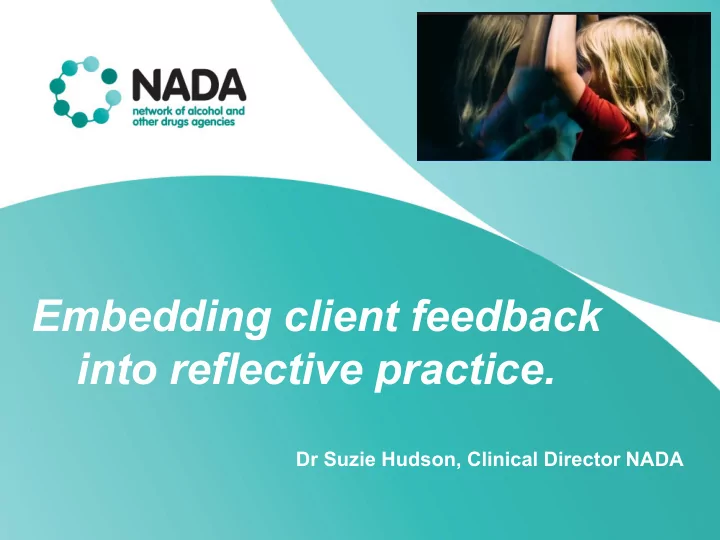

Embedding client feedback into reflective practice. Dr Suzie Hudson, Clinical Director NADA
Reflect ective p e practi actice ce What you actually do, rather than what you say you do? A way of improving practice (Schon 1976) Awareness of the theory or assumptions involved in professional practice alongside the way these assumptions are applied in practice Where is the consumer/client voice in this process?
Reflect ective p e practi actice ce Thinking Self awareness Values Consideration Understanding Analysis and Evaluation
Reflect ective p e practi actice ce Helps practitioners to identify gaps in their skills and knowledge. This helps them to identify their learning needs and improve their practice. Encourages practitioners to analyse communication and relationships. This means that relationships can be improved. Encourages a healthy questioning approach which can help practitioners “find their way”.
Feedb edbac ack Inf k Infor ormed ed T Trea eatmen ent Is an empirically supported, pantheoretical approach for evaluating and improving the quality and effectiveness of behaviour health services. It involves routinely and formally soliciting feedback from clients regarding the therapeutic alliance and outcome of care uses the results to inform and tailor service delivery (Bertolino, Bargmann & Miller. Manual 1: What Works in Therapy: A Primer on Feedback- Informed Treatment, ICCE Manuals on Feedback-Informed Treatment (FIT), (2011).
PROMS & PREMS Patient Report Outcome Measures (PROMS) & Patient Report Experience Measures (PREMS) The NSW story so far……. COQI NADAbase COMS PREMS? What is our data telling us about the outcome of therapy? What PROMS are being collected and how useful are they?
How do we use our PREMS & PROMS? Funder reporting – as part of Performance Management PROMS and PREMS data can be used to inform Quality Improvement How are we using PROMS & PREMS to inform client care/treatment in real- time?
Case Study: AOD Therapeutic Counselling AODTS MDS tells us that on average clients attend for 2 sessions of counselling Drop out rates are high AOD Counselling is oriented around “motivation for change” - what are the counsellor/therapist responsibilities in this paradigm? What might it be like to respond in real- time to clients and avoid drop-out?
Feedback Informed Treatment (FIT): How does it work? FIT utilises two brief scales at each treatment session: Outcome Rating Scale (ORS) and Session Rating Scale (SRS). The ORS seeks information from the client’s perspective on their therapeutic progress and perceived benefit of treatment while asking about the person’s level of distress and functioning. The SRS seeks the clients perception of the therapeutic alliance
Feedb edbac ack Inf k Infor ormed ed T Trea eatmen ent What do you think clinicians raise as the barriers to implementation?
Feedb edbac ack Inf k Infor ormed ed T Trea eatmen ent How can we work with those barriers?
Implementation in the Mental Health setting: A case study
Looking at the data
Embedding the feedback into reflective practice • Bring the data into the session and into supervision • Be open to the feedback and how it can shape the practice in real time • Assists with making the consumer/client the expert in their own lives
QUESTIONS
Recommend
More recommend